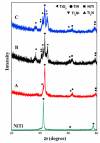Metallic Biomaterials: Current Challenges and Opportunities
- PMID: 28773240
- PMCID: PMC5578250
- DOI: 10.3390/ma10080884
Metallic Biomaterials: Current Challenges and Opportunities
Abstract
Metallic biomaterials are engineered systems designed to provide internal support to biological tissues and they are being used largely in joint replacements, dental implants, orthopaedic fixations and stents. Higher biomaterial usage is associated with an increased incidence of implant-related complications due to poor implant integration, inflammation, mechanical instability, necrosis and infections, and associated prolonged patient care, pain and loss of function. In this review, we will briefly explore major representatives of metallic biomaterials along with the key existing and emerging strategies for surface and bulk modification used to improve biointegration, mechanical strength and flexibility of biometals, and discuss their compatibility with the concept of 3D printing.
Keywords: advanced materials; biomaterial; implant; inflammation; surface modification.
Conflict of interest statement
The authors declare no conflict of interest.
Figures











References
-
- Global Bio-Implants Market Worth $134.3 Billion by 2017. [(accessed on 19 June 2017)];2017 Available online: http://www.marketsandmarkets.com/PressReleases/bio-implants.asp.
-
- Ige O.O., Umoru L.E., Aribo S. Natural products: A minefield of biomaterials. ISRN Mater. Sci. 2012;2012:983062:1–983062:20. doi: 10.5402/2012/983062. - DOI
-
- Lu J.Z., Wu L.J., Sun G.F., Luo K.Y., Zhang Y.K., Cai J., Cui C.Y., Luo X.M. Microstructural response and grain refinement mechanism of commercially pure titanium subjected to multiple laser shock peening impacts. Acta Mater. 2017;127:252–266. doi: 10.1016/j.actamat.2017.01.050. - DOI
-
- Trivedi P., Nune K.C., Misra R.D.K., Goel S., Jayganthan R., Srinivasan A. Grain refinement to submicron regime in multiaxial forged Mg-2Zn-2Gd alloy and relationship to mechanical properties. Mater. Sci. Eng. A. 2016;668:59–65. doi: 10.1016/j.msea.2016.05.050. - DOI
Publication types
LinkOut - more resources
Full Text Sources
Other Literature Sources

